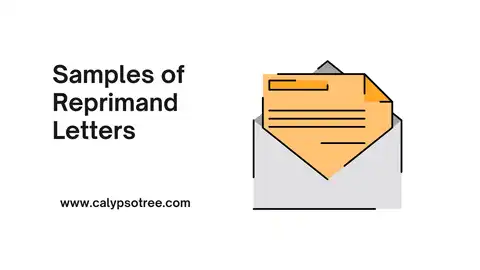How to write a motivation Letter for scholarship application? Crafting a motivation letter for a scholarship application can seem challenging. This letter is your chance to prove to the scholarship committee why you are a deserving candidate. This article will inform you of the steps to create a clear and persuasive motivational letter.
How to Write a Motivation Letter for Scholarship Application
Here is a step to help you write a clear, compelling motivation letter.
1. Understanding the Purpose of a Motivation Letter
It highlights your dedication, goals, and reasons for needing financial support. A clear motivation letter contains personal details, academic achievements, and career aspirations.
2. Preparing to Write Your Motivation Letter
Before you begin writing, preparation is essential. Here are some steps to help you get ready:
Research the Scholarship Organization:
- What this means: Understand the values and goals of the organization offering the scholarship.
- How to do it: Visit their website, read their mission statement, and review profiles of past recipients.
- Example: If the scholarship supports environmental initiatives, mention your related projects or activities.
Understand the Scholarship Requirements:
- What this means: Familiarize yourself with the application requirements.
- How to do it: Carefully read the instructions and check if you need to include transcripts, letters of recommendation, or a resume.
- Example: If the scholarship requires a 3.5 GPA, ensure you mention your GPA in the letter.
Gather Necessary Information About Yourself:
- What this means: Collect details about your academic and personal achievements.
- How to do it: List your awards, clubs, and any relevant experiences.
- Example: If you are a member of a science club and won a science fair, highlight this in your letter.
Make a List of Your Accomplishments:
- What this means: Document your achievements to demonstrate why you are a good candidate.
- How to do it: Include academic achievements, volunteer work, and extracurricular activities.
- Example: Mention leadership roles, such as being class president, which show responsibility and dedication.
Think About Your Career Goals:
- What this means: Reflect on your long-term aspirations and how the scholarship will help you achieve them.
- How to do it: Write down your career goals and explain how the scholarship will support them.
- Example: If you aim to become a doctor, describe how the scholarship will help you afford medical school and focus on your studies.
Plan Your Letter:
- What this means: Organize your thoughts and structure your letter.
- How to do it: Create an outline with key points for each section of your letter.
- Example: Draft key points for your introduction, academic background, personal achievements, and career goals.
3. Structuring Your Motivation Letter
Your motivation letter should follow a clear structure:
- Header: Your contact information.
- Recipient’s Information: Contact details of the scholarship committee.
- Subject Line: State the purpose of the letter.
- Salutation: A respectful greeting.
- Body: Includes introduction, academic background, personal achievements, career goals, reasons for applying, and connection to the scholarship.
- Conclusion: Summarize key points and express gratitude.
- Sign-off: Formal closing and your name.
- Attachments: List of attached documents.
4. Writing the Introduction
Introduce yourself and the scholarship you are applying for, and briefly state why you are applying. This sets the tone for the rest of your letter.
5. Highlighting Your Academic Background
Detail your academic achievements to show your dedication to your studies.
Mention Your Courses:
- What this means: List relevant subjects you have studied.
- How to do it: Highlight courses important to your future career.
- Example: “I have taken advanced courses in math and science, preparing me for a career in engineering.”
Talk About Your Grades:
- What this means: Share your grades to demonstrate your academic performance.
- How to do it: Mention your GPA and high marks in specific subjects.
- Example: “I have maintained a 3.8 GPA, with A’s in all my science classes.”
List Any Honors or Awards:
- What this means: Mention any special recognition you have received.
- How to do it: Include awards, honors, or scholarships you have earned.
- Example: “I received the Best Student in Science Award and a scholarship for academic excellence.”
Explain Why These Are Important:
- What this means: Show why your academic achievements matter.
- How to do it: Connect your achievements to your future goals.
- Example: “These accomplishments demonstrate my dedication to learning and readiness for college-level work.”
6. Showcasing Your Personal Achievements
Describe your extracurricular activities and volunteer work to provide a fuller picture of who you are.
Discuss Extracurricular Activities:
- What this means: Highlight your involvement in clubs and sports.
- How to do it: Mention activities that showcase your skills and interests.
- Example: “I am the captain of the school’s soccer team and a member of the debate club.”
Highlight Volunteer Work:
- What this means: Share your volunteer experiences.
- How to do it: Describe where you volunteered and what you did.
- Example: “I volunteer at the local animal shelter, helping care for the animals and organize adoption events.”
Share Personal Accomplishments:
- What this means: Mention other personal successes.
- How to do it: Include achievements that show your character.
- Example: “I organized a neighborhood cleanup day, bringing together over 50 volunteers.”
Explain Why These Matter:
- What this means: Show why your personal achievements are important.
- How to do it: Connect them to your goals and values.
- Example: “These activities have taught me leadership, teamwork, and the importance of giving back to the community.”
7. Explaining Your Career Goals
Outline your long-term career plans and how the scholarship will help you achieve them.
State Your Long-Term Goals:
- What this means: Clearly explain your future career plans.
- How to do it: Be specific about your aspirations.
- Example: “I want to become a doctor and help people in under-served communities.”
Show How the Scholarship Will Help:
- What this means: Explain how the scholarship supports your goals.
- How to do it: Describe the financial and educational benefits.
- Example: “This scholarship will allow me to focus on my studies without worrying about tuition costs.”
Connect Your Goals to the Scholarship:
- What this means: Align your goals with the scholarship’s purpose.
- How to do it: Mention the scholarship’s values and how they align with your goals.
- Example: “This scholarship supports future healthcare professionals, which aligns with my goal of becoming a doctor.”
Explain Why These Goals Are Important:
- What this means: Highlight the significance of your career goals.
- How to do it: Describe the impact you want to make.
- Example: “Becoming a doctor will allow me to make a positive impact by providing much-needed healthcare.”
8. Reasons for Applying for the Scholarship
Clearly articulate why you need the scholarship:
Detail Your Financial Need:
- Purpose: Explain your financial situation and why you need support.
- Approach: Be transparent and provide specific details about your circumstances.
Align the Scholarship with Your Academic Goals:
- Purpose: Show how the scholarship will help you achieve your academic objectives.
- Approach: Describe how the funding will enhance your educational experience.
Connect the Scholarship to Your Career Aspirations:
- Purpose: Illustrate how the scholarship will support your long-term career plans.
- Approach: Present a clear and detailed plan for your future, highlighting the role of the scholarship.
Highlight Relevant Skills or Experiences:
- Purpose: Showcase abilities or experiences that make you a strong candidate.
- Approach: Provide concrete examples that demonstrate your qualifications.
Justify Your Choice of This Scholarship:
- Purpose: Explain why you selected this particular scholarship.
- Approach: Mention specific aspects of the scholarship that resonate with you.
Share Personal Stories or Examples:
- Purpose: Make your application more relatable through personal anecdotes.
- Approach: Use specific life examples to illustrate your points.
Express Positivity and Enthusiasm:
- Purpose: Convey your excitement and gratitude for the opportunity.
- Approach: Use positive language to show your enthusiasm.
9. Connecting Your Values with the Scholarship
Demonstrate how your values align with those of the scholarship:
Research the Scholarship’s Principles and Goals:
- Purpose: Understand the core beliefs and objectives of the scholarship provider.
- Approach: Explore their website and mission statements thoroughly.
Articulate Your Own Values and Aspirations:
- Purpose: Reflect on your personal beliefs and future ambitions.
- Approach: Write down and clearly define your values and career goals.
Demonstrate Value Alignment:
- Purpose: Show the connection between your values and those of the scholarship.
- Approach: Use specific examples to illustrate this alignment.
Highlight the Importance of Shared Values:
- Purpose: Emphasize the significance of having shared values with the scholarship provider.
- Approach: Explain how these shared values will help you achieve your goals.
10. Writing the Conclusion
Wrap up your letter by summarizing key points and expressing gratitude.
Summarize Key Points:
- What this means: Recap the main points of your letter.
- How to do it: Keep it brief and to the point.
Reiterate Your Interest:
- What this means: Show your strong interest in the scholarship.
- How to do it: Mention again how much the scholarship means to you.
Thank the Committee:
- What this means: Express your gratitude.
- How to do it: Use polite and respectful language.
Provide a Strong Closing Statement:
- What this means: End on a positive and memorable note.
- How to do it: Make a final statement that leaves a good impression.
11. Finalizing Your Letter
Ensure your letter is perfect before sending it.
Proofread for Errors:
- What this means: Check for spelling, grammar, or punctuation mistakes.
- How to do it: Read your letter carefully or use a spell-check tool.
Ensure Clarity and Simplicity:
- What this means: Make sure your letter is easy to read and understand.
- How to do it: Use simple words and short sentences.
Ask Someone Else to Review It:
- What this means: Get feedback from a fresh pair of eyes.
- How to do it: Ask a teacher, friend, or family member to review your letter.
12. Attaching Supporting Documents
Include any necessary documents with your letter.
List Any Attached Documents:
- What this means: Clearly state what documents are included.
- How to do it: Make a list at the end of your letter.
Ensure All Documents Are Properly Labeled:
- What this means: Label each document with your name and its purpose.
- How to do it: Write your name and the type of document on each one.
Double-Check Everything:
- What this means: Make sure all required documents are included.
- How to do it: Go through the scholarship requirements and check off each document.
Common Mistakes to Avoid
Avoid these common pitfalls when writing your letter.
Avoid Generic Statements:
- What this means: Be specific about your experiences and goals.
- Example: Instead of “I am a hardworking student,” say “I have consistently achieved top grades in my math and science courses.”
Provide Enough Detail:
- What this means: Give detailed examples and explanations.
- Example: Instead of “I volunteered at a local shelter,” say “I helped care for animals, organized adoption events, and raised funds for supplies.”
Align with Scholarship Values:
- What this means: Show how your values match the scholarship’s.
- Example: If the scholarship values community service, highlight your volunteer work.
Proofread for Errors:
- What this means: Check for mistakes to ensure professionalism.
- Tip: Read your letter out loud or ask someone else to review it.
Stay Focused:
- What this means: Keep your letter on point.
- Tip: Stick to the structure and ensure each paragraph has a clear purpose.
Be Honest:
- What this means: Be truthful about your achievements.
- Example: Focus on significant activities even if you haven’t received many awards.
Avoid Negative Language:
- What this means: Stay positive.
- Tip: Highlight how you overcame difficulties and what you learned.
Be Professional:
- What this means: Use a formal tone.
- Tip: Start with “Dear Members of the Scholarship Committee” and end with “Sincerely, [Your Name].”
Keep It Concise:
- What this means: Be brief and to the point.
- Tip: Ensure each sentence adds value and remove unnecessary words.
Show Enthusiasm:
- What this means: Let your passion shine through.
- Example: Instead of “I want this scholarship,” say “I am thrilled about the opportunity to further my education with this scholarship.”
Motivation Letter for Scholarship Application Template
Motivation Letter for Scholarship Application
Header: Your Name Your Address City, State, ZIP Code Email Address Phone Number Date
Recipient’s Information: Scholarship Committee Name of the Scholarship Organization Address City, State, ZIP Code
Subject Line: Application for [Scholarship Name]
Salutation: Dear Members of the Scholarship Committee,
Introduction: My name is [Your Name], and I am applying for the [Scholarship Name]. I am very excited about this opportunity because [brief reason for applying].
Academic Background: I have excelled in my studies at [School Name], where I have maintained a [GPA] GPA. My coursework in [relevant subjects] has prepared me well for a career in [career field]. I have also received [honors/awards].
Personal Achievements: Outside of academics, I have been involved in [extracurricular activities]. I also volunteer at [organization], where I [describe volunteer work]. These experiences have helped me develop [skills/character traits].
Career Goals: My long-term goal is to become a [career goal]. This scholarship will help me achieve this by [how the scholarship will help]. With this support, I can focus on my studies and gain the skills needed for my future career.
Reasons for Applying: I am applying for this scholarship because [specific reason]. This financial support will allow me to [what you will do with the scholarship]. It aligns perfectly with my academic and career goals.
Connection to Scholarship: The values of [Scholarship Organization] align with my own. I believe in [values], which is why I am drawn to this scholarship. This alignment strengthens my desire to be part of your program.
Conclusion:
Thank you for considering my application. I am truly excited about the possibility of receiving this scholarship and furthering my education at [School/Program]. I appreciate your time and consideration.
Sign-off: Sincerely, [Your Name]
Attachments:
- Transcript
- Letters of Recommendation
- Resume
Sample Motivation Letter for Scholarship Application
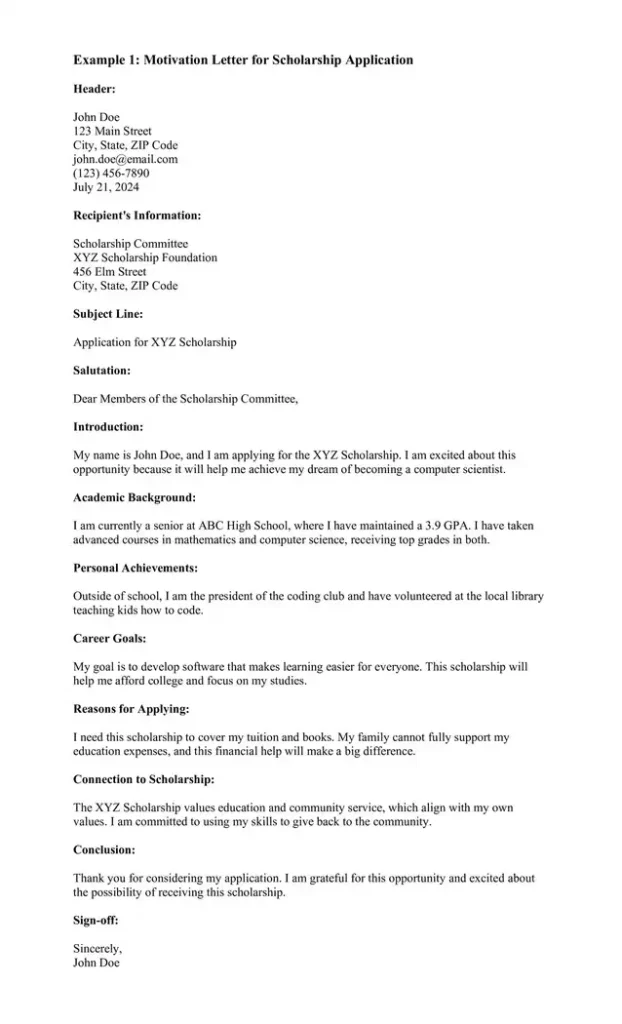
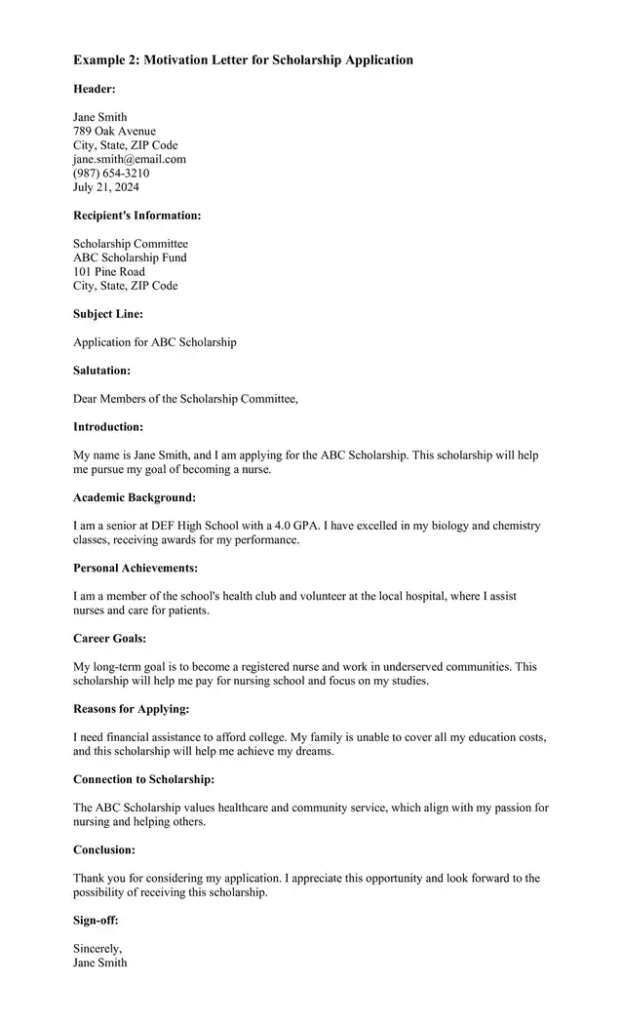
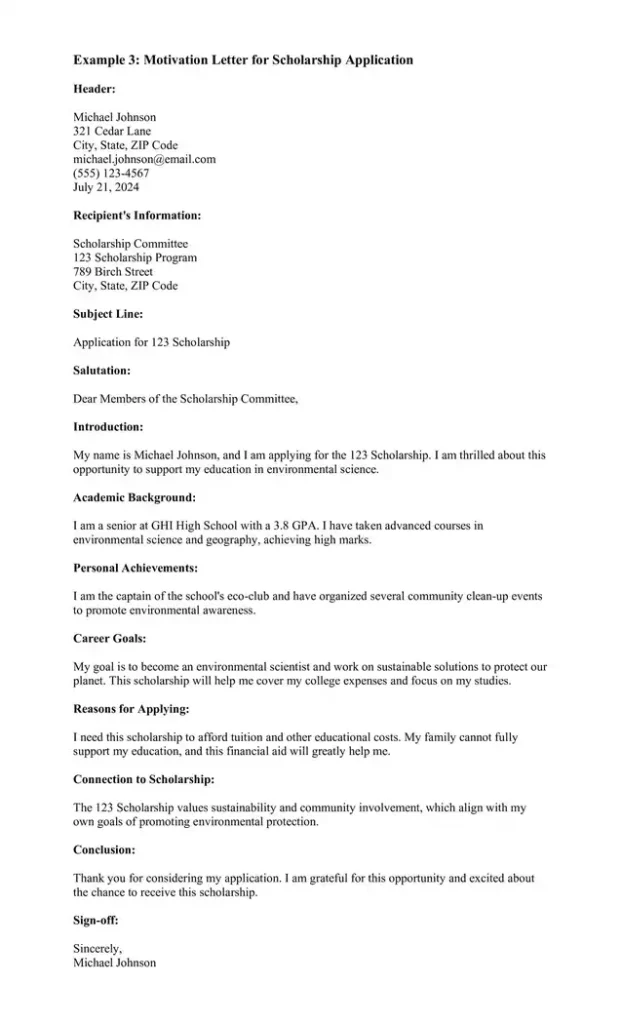
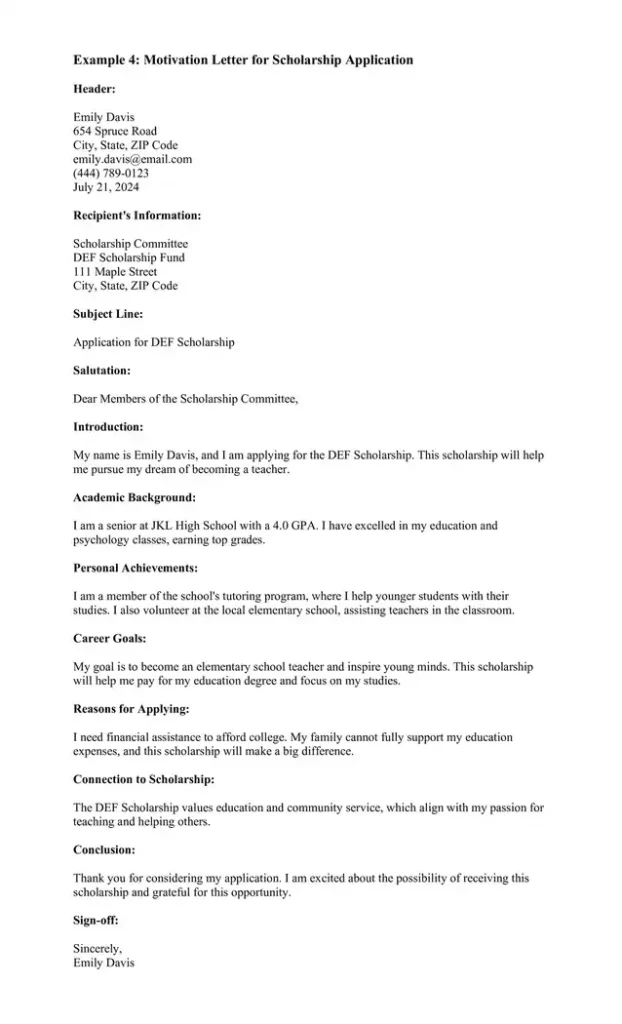
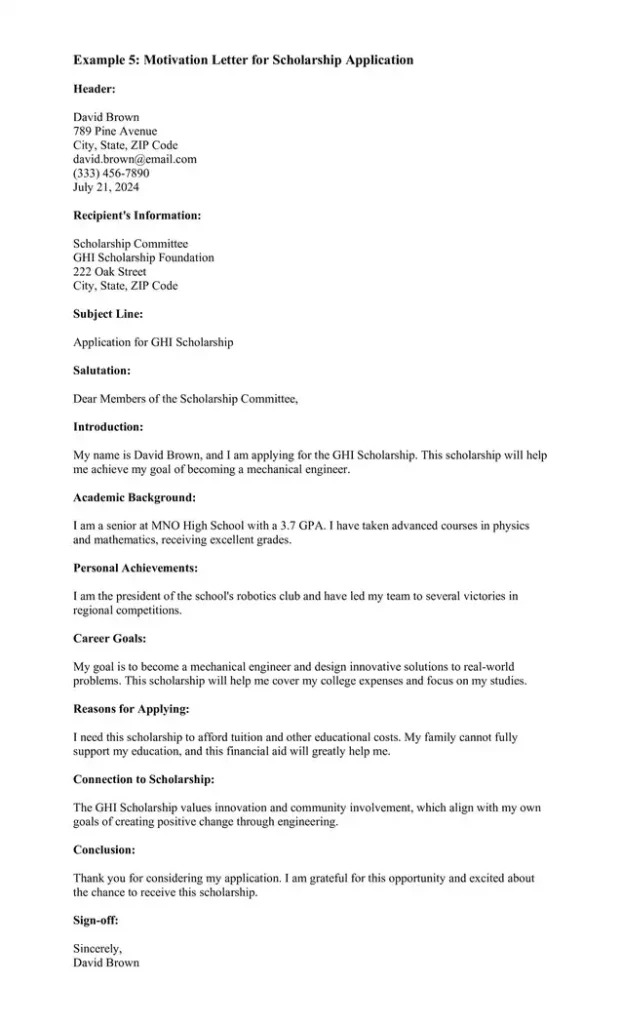
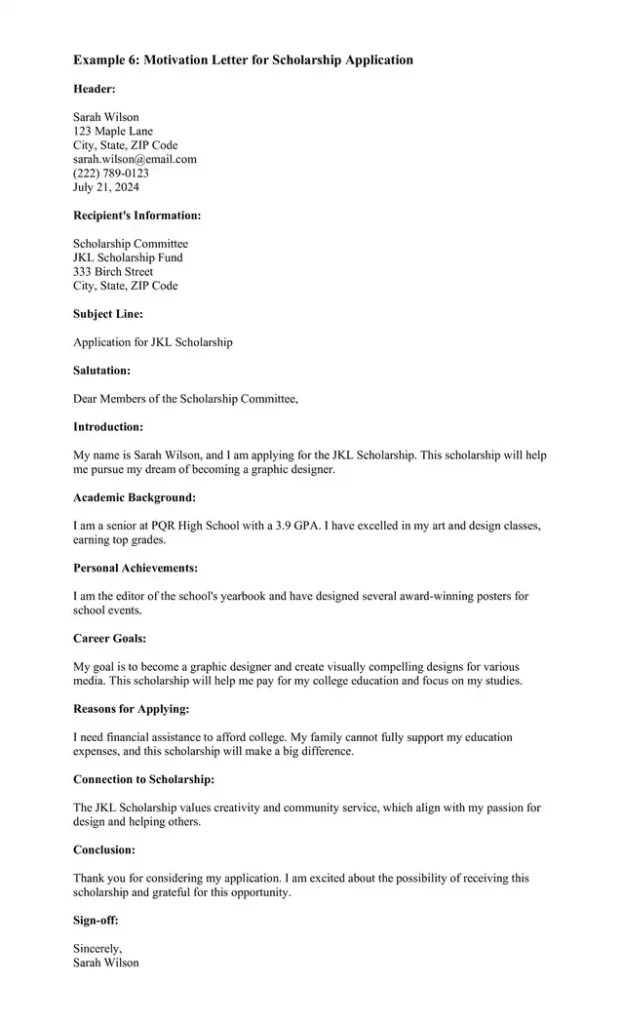
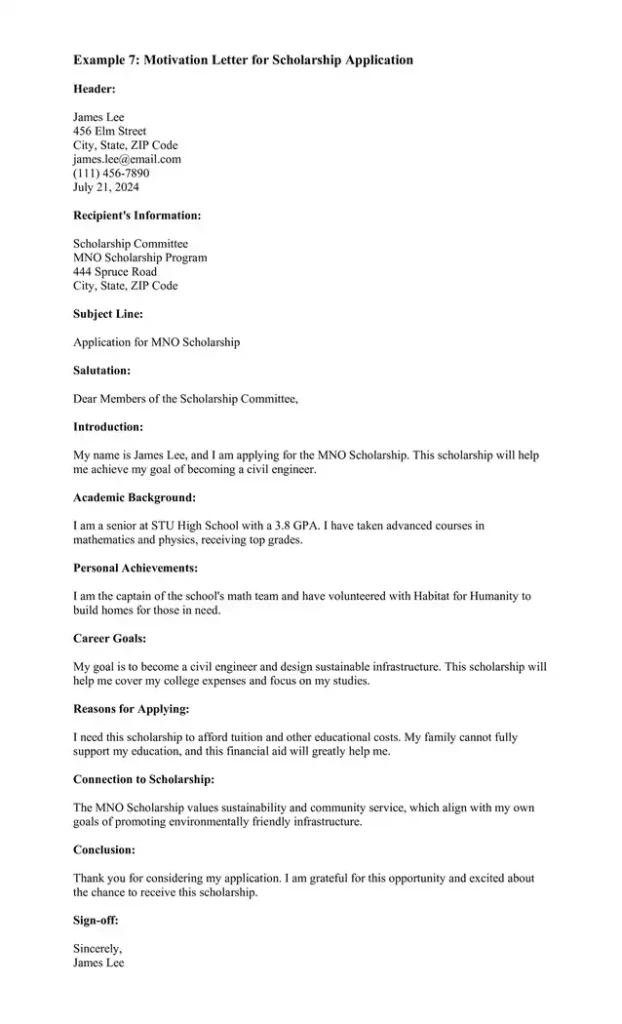
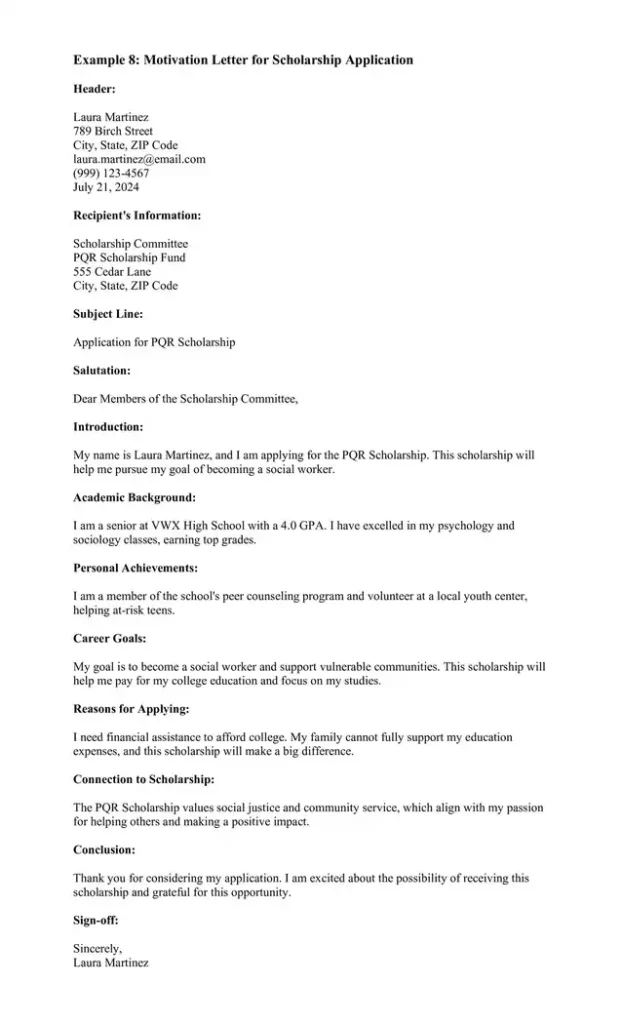
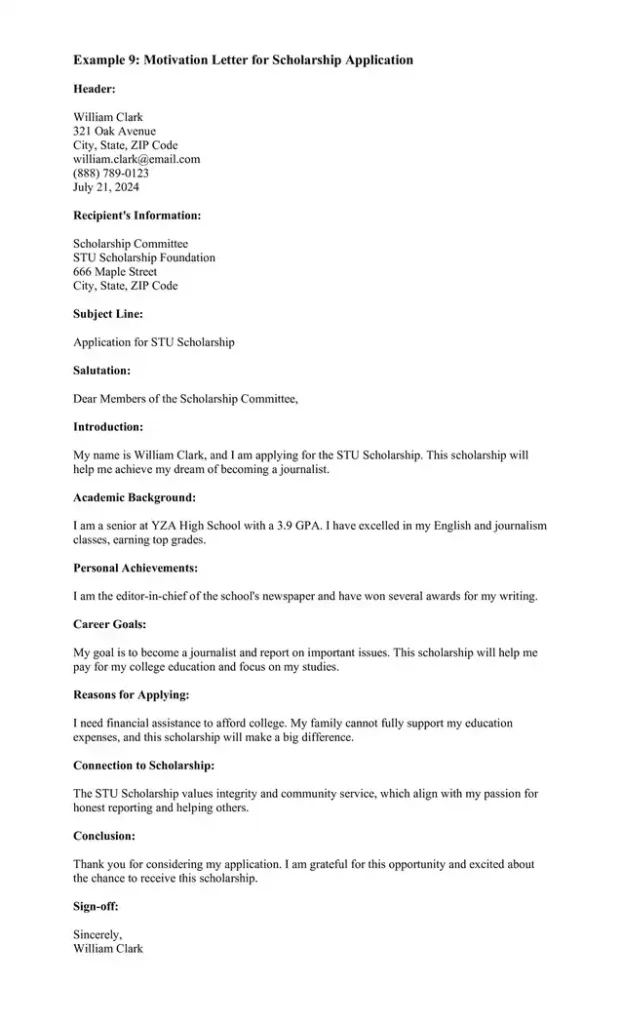
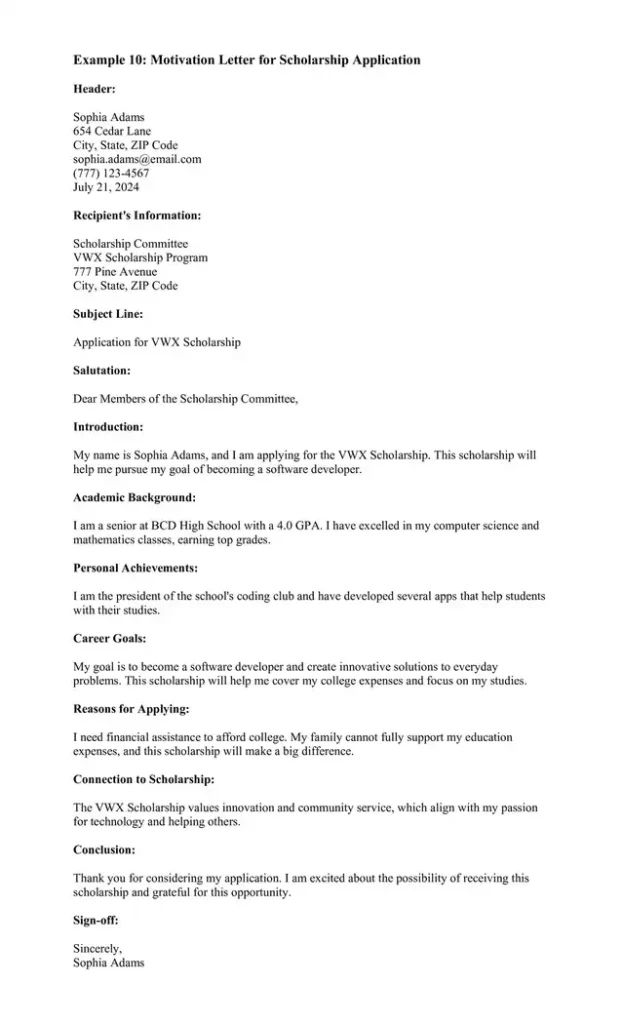
Conclusion
Writing a motivation letter for a scholarship application requires careful thought and planning. By following this guide, you can create a strong, clear, and compelling letter. Take your time, be honest, and show the scholarship committee why you deserve their support. Good luck!

Daniel Wilson Is a Seasoned communications professional and letter-writing expert. With over a decade of experience in corporate and non-profit sectors, Has developed a deep understanding of the power of effective communication.
Specializes in creating versatile letter templates that can be tailored to any situation. In this blog, Daniel shares a passion for the art of letter writing, offering practical tips, customizable templates, and inspiring ideas to help you communicate with clarity, confidence, and impact.







